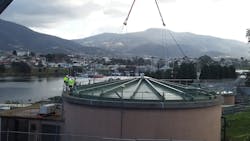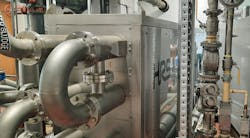TasWater is the water and sewage utility for the island state of Tasmania in Australia. Owned by Tasmania’s 29 local councils and the state government, TasWater is responsible for providing drinking water and collecting and treating sewage for the 540,000 people who live across the state.
In 2020, TasWater and main contractor Aquatec Maxcon undertook a multimillion-dollar upgrade of the Prince of Wales Bay Sewage Treatment Plant in Hobart.
The treatment plant is one of the oldest sewage plants in Tasmania and the refurbishments, which included a new roof for the main anaerobic digester, will allow the facility to cope with the growing demand for wastewater treatment in the region. These improvements will ensure the plant’s operational suitability until 2060 as part of TasWater’s 10-year investment program.
As part of the upgrade package, HRS Heat Exchangers supplied Aquatec Maxcon with a corrugated tube heat exchanger to warm the recirculating sludge and maintain optimum operating temperatures in the main digester. As Tasmania is the southernmost and coldest state in Australia, maintaining digester temperature is crucial to efficient operation — particularly in the winter months when there is an increase in heat loss from the liquid sludge nearer the top of the tank.
“There were a number of heat exchanger suppliers that we could have chosen, but one of the issues we faced was a limit of the space available for the heat exchanger, and the HRS unit had slightly smaller dimensions than some others for the same thermal performance,” says Jim Foley, Project Engineer for Aquatec Maxcon. “HRS provided me a with a reference, and, after that and a performance test, we were happy to go with the HRS product.”
Despite the challenges of a global pandemic, the heat exchanger, which was manufactured at HRS’s factory in Spain, was delivered well ahead of the required installation date.
Since operation, the unit has performed according to specification, dealing with a range of feedstocks and sludges, including sewerage sludge as well as fats and oils from trade wastes.
“As an engineer on a project such as this, you tend to focus on areas where you have problems,” says Foley. “I’m happy to say there were no problems with the heat exchanger.” WW
Published in WaterWorld magazine, November 2022.
About the Author
Matt Hale
Matt Hale is International Sales & Marketing Director for HRS Heat Exchangers.


